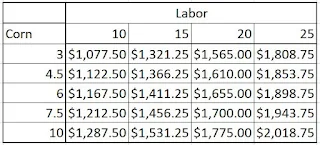This is a crude, back of envelop approximation based on prices that are external to the farm.
It assumes that the "rancher" will pour 30 bushels of corn into each animal before slaughter. Some of that will be creep-feed early in the animals life. The rest will be to finish the animal to 1300 pound slaughter weight.
It assumes $500/calf cash outlay between the price of the young calf and shipping costs.
It extrapolates the slaughter-costs based on local prices of $0.75 a pound when Michigan minimum wage is approximately $10 per hour.
 |
| Variable cost, per calf, to the beef aging in the cooler |
But that "beef" with a hanging weight of 650 pounds is not all edible meat. In fact, almost half of that is bone, sinew and excess fat. Assuming the butcher can get 350 pounds of edible beef from 650 pounds of hanging weight the variable costs per pound are
There are many feedback mechanisms that make this simple analysis fall apart.
Rapidly rising cattle prices drop the price of calves as producers hedge their bets regarding their ability to fully pass rising prices to the consumer.
Producers might feed less corn to fatten the beef.
A third option is that a family might choose to slaughter and cut-up their own beef which reduces the per-animal cost by at least $480.

Not much commentary on the open market, but I reckon inflation for consumer goods, when gasoline is included, is around 10% right now. You'll notice that a lot of packaging in processed foods - crackers, cereals, etc. - get incrementally smaller over time, while the price range is preserved; you'll see boxes with odd, fractional ounces as their package weight, e.g. 16 oz. becomes 13.7 oz. over the course of a week. Meat, in particular beef, has risen dramatically since last fall. All in all, Beef and gas prices seem to be inflating more quickly than other commodities.....
ReplyDeleteLately, in many locations, the option of slaughter and cut up yourself is exactly that. Meaning many of the smaller pac-butcher shops ( sometimes called locker plants) etc are booked solid for months in advance. It used to you could buy a steer from a farmer, pay to have it processed and still save money. Recently, not so much. Back last year when multiple packing plants were shut down because the entire production lines were out sick.....farmers were selling to about anyone at near cost. Many are still selling at just a fraction over cost...and yet unless you want to cut and wrap the beef yourself you may find it nearly impossible to find someone to process it for you.
ReplyDeleteThe big meat processors can only process cattle that fit within a very limited size and weight range and many of those cattle out there have grown out of it so the ranchers are in a real bind which accounts for those really good prices on the hoof. But as noted the small meat cutters are over worked and tend to charge a lot. And add in the cost to buy and run a freezer and it goes up more. But I don't trust the system so whatcha gonna do? Watch some butchering Youtubes and try to get some one with experience to help and do it yourself. Ain't easy but it's doable.---ken
ReplyDeleteThe Captain, my recently deceased neighbor, used to sell many of his cattle to the Hmong on-the-hoof.
DeleteHe would shoot them behind the ear with whichever hunting firearm was closest to hand. He lifted it up on his frontend loader and went inside to have a cup of coffee (or two).
Going outside two hours later, there was nothing but trampled grass left.
I watched the start of the process once. They spread a tarp beneath the beef on the front-end loader. They treked to the minivans and brought tubs, butcher knives (aka, machetes) and aprons. They took EVERYTHING.
A lot of work but a lot of protein. My best-guess is that the meat went to three families.
It would be interesting to watch them do it. I've heard stories but never saw Hmong do it. Did The Captain hang the cow head up or head down for them? ---ken
DeleteGreat reading your bllog post
ReplyDelete